英语简单句、并列句、复合句
英语句子分类之简单句,并列句和复合句
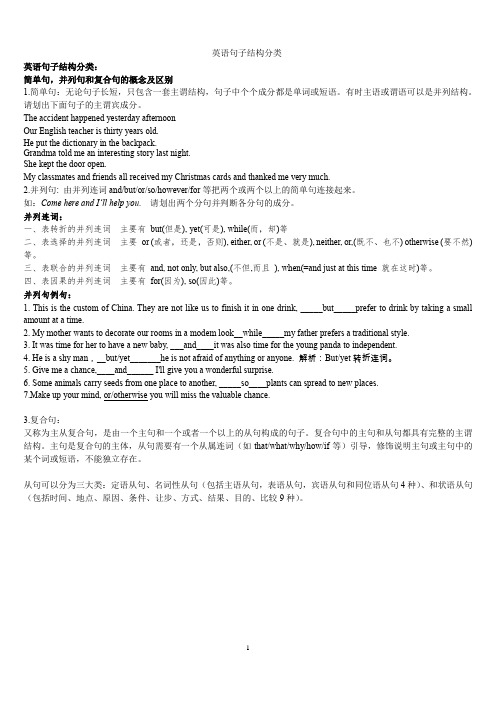
英语句子结构分类英语句子结构分类:简单句,并列句和复合句的概念及区别1.简单句:无论句子长短,只包含一套主谓结构,句子中个个成分都是单词或短语。
有时主语或谓语可以是并列结构。
请划出下面句子的主谓宾成分。
The accident happened yesterday afternoonOur English teacher is thirty years old.He put the dictionary in the backpack.Grandma told me an interesting story last night.She kept the door open.My classmates and friends all received my Christmas cards and thanked me very much.2.并列句: 由并列连词and/but/or/so/however/for等把两个或两个以上的简单句连接起来。
如:Come here and I’ll help you. 请划出两个分句并判断各分句的成分。
并列连词:一、表转折的并列连词主要有but(但是), yet(可是), while(而,却)等二、表选择的并列连词主要or (或者,还是,否则), either, or (不是、就是), neither, or,(既不、也不) otherwise (要不然)等。
三、表联合的并列连词主要有and, not only, but also,(不但,而且), when(=and just at this time 就在这时)等。
四、表因果的并列连词主要有for(因为), so(因此)等。
并列句例句:1. This is the custom of China. They are not like us to finish it in one drink, _____but_____prefer to drink by taking a small amount at a time.2. My mother wants to decorate our rooms in a modem look__while_____my father prefers a traditional style.3. It was time for her to have a new baby, ___and____it was also time for the young panda to independent.4. He is a shy man,__but/yet_______he is not afraid of anything or anyone. 解析:But/yet转折连词。
简单句 并列句 复合句
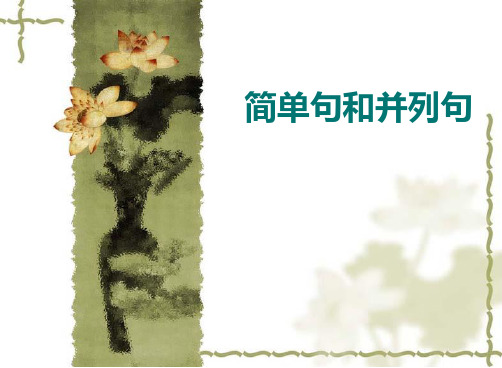
1. 陈述句(Declarative Sentences)
用来说明一个事实或陈述一种看法。例如: 1) Light travels faster than sound.
光比声传播速度快。(说明事实) 2) The film is rather boring.
这部电影很乏味。(说明看法)
要特别注意陈述句的否定结构
6. 状语 ( Adverbial )
常指修饰动词、形容词或副词的成分,修饰动词时 表示动作发生的时间、地点、目的或方式等;修饰 形容词或副词时表示它们的程度等。状语常由副词、 介词短语、动词不定式或分词短语等充当。 例如: 1. The miners work very hard. 2. She often helps Mike at school. 3. Hearing the news, he couldn’t help jumping.
3. 宾语 ( Object )
常指及物动词或介词后面使之意思完整的词或短语。 常由名词、代词、动词不定式或动名词短语等充当。 例如: 1. She has finished doing the experiment. 2. We like English and are good at it.
4. 表语 ( Predicative )
5)主 + 动 + 间宾 + 直宾 例如: My mother made me a new dress. 我母亲给我做了一件新衣裳。
IV. 并列句的常用连词
1. 我们常用并列连词and, not only…but also…等 连接联合并列句,用not only…but also… 时, 前面一句要用部分倒装 。例如: 1)Use your head, and you’ll find a way. 2)Not only does he want to come, but the students also need him.
高考英语复习句子分类之简单句,并列句和复合句知识点
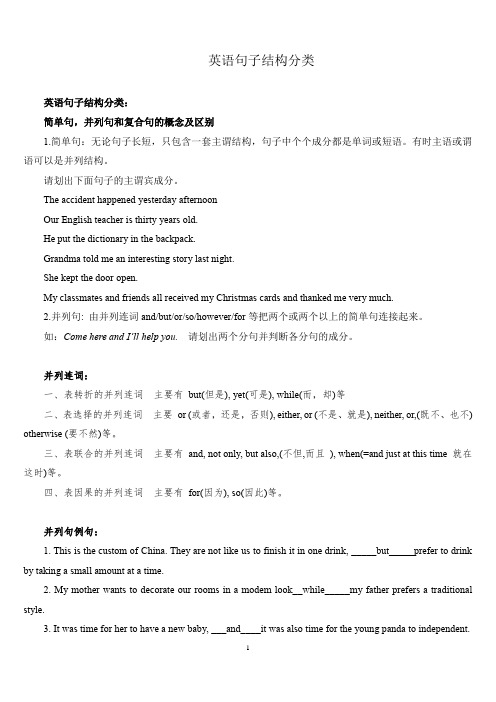
英语句子结构分类英语句子结构分类:简单句,并列句和复合句的概念及区别1.简单句:无论句子长短,只包含一套主谓结构,句子中个个成分都是单词或短语。
有时主语或谓语可以是并列结构。
请划出下面句子的主谓宾成分。
The accident happened yesterday afternoonOur English teacher is thirty years old.He put the dictionary in the backpack.Grandma told me an interesting story last night.She kept the door open.My classmates and friends all received my Christmas cards and thanked me very much.2.并列句: 由并列连词and/but/or/so/however/for等把两个或两个以上的简单句连接起来。
如:Come here and I’ll help you. 请划出两个分句并判断各分句的成分。
并列连词:一、表转折的并列连词主要有but(但是), yet(可是), while(而,却)等二、表选择的并列连词主要or (或者,还是,否则), either, or (不是、就是), neither, or,(既不、也不) otherwise (要不然)等。
三、表联合的并列连词主要有and, not only, but also,(不但,而且), when(=and just at this time 就在这时)等。
四、表因果的并列连词主要有for(因为), so(因此)等。
并列句例句:1. This is the custom of China. They are not like us to finish it in one drink, _____but_____prefer to drink by taking a small amount at a time.2. My mother wants to decorate our rooms in a modem look__while_____my father prefers a traditional style.3. It was time for her to have a new baby, ___and____it was also time for the young panda to independent.4. He is a shy man,__but/yet_______he is not afraid of anything or anyone. 解析:But/yet转折连词。
简单句、并列句和复合句的区别
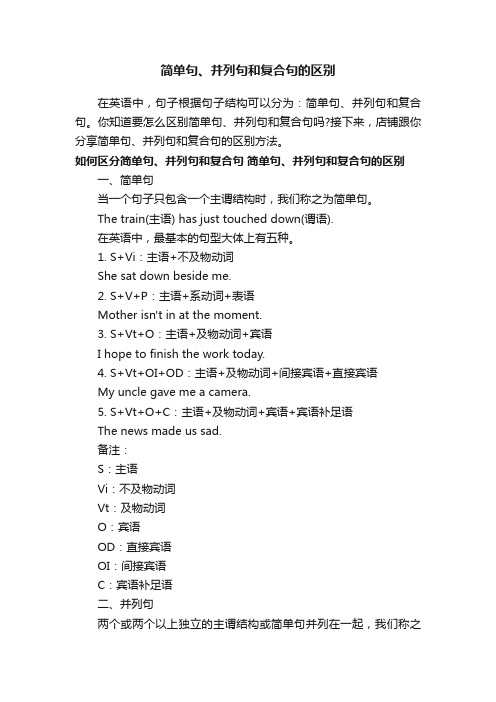
简单句、并列句和复合句的区别在英语中,句子根据句子结构可以分为:简单句、并列句和复合句。
你知道要怎么区别简单句、并列句和复合句吗?接下来,店铺跟你分享简单句、并列句和复合句的区别方法。
如何区分简单句、并列句和复合句简单句、并列句和复合句的区别一、简单句当一个句子只包含一个主谓结构时,我们称之为简单句。
The train(主语) has just touched down(谓语).在英语中,最基本的句型大体上有五种。
1. S+Vi:主语+不及物动词She sat down beside me.2. S+V+P:主语+系动词+表语Mother isn't in at the moment.3. S+Vt+O:主语+及物动词+宾语I hope to finish the work today.4. S+Vt+OI+OD:主语+及物动词+间接宾语+直接宾语My uncle gave me a camera.5. S+Vt+O+C:主语+及物动词+宾语+宾语补足语The news made us sad.备注:S:主语Vi:不及物动词Vt:及物动词O:宾语OD:直接宾语OI:间接宾语C:宾语补足语二、并列句两个或两个以上独立的主谓结构或简单句并列在一起,我们称之为并列句。
各个简单句间是平行并列的关系,而非从属关系。
并列句的各个分句间可用逗号、分号、起连接作用的副词或并列连接词来连接。
1. 能连接并列句的连词and(和,又),but(但是),for(因为),however(然而),or(或者),so(所以,因而),while(然而),yet(然而)2. 能连接并列句的复合连词or else(否则,要不然),either...or...(要么···,要么···;或者···,或者···),neither...nor...(既不···,也不···),not only...but also(不仅···,而且···)3. 能连接并列句的副词besides(而且,还有),hence(因此),otherwise(否则,要不然),then(然后,于是),therefore(因此,所以),thus(因而,从而) 根据并列分句之间的不同关系,并列句则可以分为以下四种。
英语几大句型
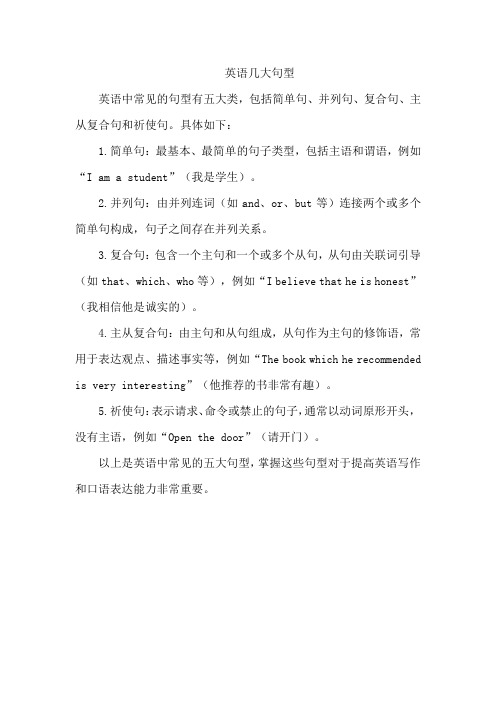
英语几大句型
英语中常见的句型有五大类,包括简单句、并列句、复合句、主从复合句和祈使句。
具体如下:
1.简单句:最基本、最简单的句子类型,包括主语和谓语,例如“I am a student”(我是学生)。
2.并列句:由并列连词(如and、or、but等)连接两个或多个简单句构成,句子之间存在并列关系。
3.复合句:包含一个主句和一个或多个从句,从句由关联词引导(如that、which、who等),例如“I believe that he is honest”(我相信他是诚实的)。
4.主从复合句:由主句和从句组成,从句作为主句的修饰语,常用于表达观点、描述事实等,例如“The book which he recommended is very interesting”(他推荐的书非常有趣)。
5.祈使句:表示请求、命令或禁止的句子,通常以动词原形开头,没有主语,例如“Open the door”(请开门)。
以上是英语中常见的五大句型,掌握这些句型对于提高英语写作和口语表达能力非常重要。
英语句子类型简单句并列句复合句
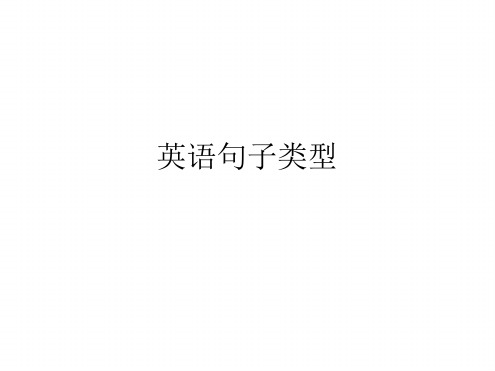
定语从句
英语中的定语是一个词时,放在被修饰词的前面, ①a beautiful girl ②a lovely boy (形容词作定语)
定语是两个以上的词组、短语或从句则放在被修饰词的后面, 如: ③She is the girl in red. (介词短语作定语) ④The lady carried a bag full of money. (形容词短语作定语) ⑤He is the man who you are looking for. (定语从句作定语)
先行词和关系词的关系
1.A plane is a machine that can fly.
a machine = that
2.The boy who broke the window is called Tom.
the boy = who 关系代词实际上是先行词的复指
3.The boy whose parents are dead was brought up by his grandfather. the boy 's =whose
There existed many dinosaurs.
简单句的基本词序
主语
动词部分 宾语
状语
(谓语)
(方式 /地点/时间)
I
boay.
The children ran
home.
We
ate
our meal
in silence.
The car
stopped
suddenly.
关系词whose 实际上是先行词的所有格
4.The school where I study is far from my home.
简单句及并列句和复合句

一.五种简单句1.主语+不及物动词(主+谓)He laughed.2.主语+及物动词+宾语(主+谓+宾)I like Chinese food.3..主语+及物动词+间接宾语+直接宾语(主+谓+宾1+宾2)She taught them physics.4.主语+及物动词+宾语+宾语补足语(主+谓+宾+宾补)We must keep the room warm.5. 主语+连系动词+表语(主+系+表)The weather is very cold.二.并列句He is a worker and I am a worker, too.He is very happy but his mother is very sad.上述两句地位一样,如同湖北的省长和湖南的省长一样,地位相等,称为并列句。
三.主从复合句If you are free, we will go to Beijing to play.前者地位低,为后面的主句服务,叫从句。
后者地位高,为主句。
两句合二为一,为主从复合句。
问题:主句与从句怎么辨别?四.从句种类很多。
句子成分划分:主语,谓语,宾语,定语,状语,补语,表语,同位语。
(8种)(主语从句,宾语从句,表语从句,同位语从句)-----名词性从句(定语从句)------形容词性从句(状语从句)------副词性从句Whether we will go shopping depends on the weather.( )He said that he wanted to go to town. ( )That is what I wanted. ( )Y ou are the man who I am looking for. ( )I will help you although I am not very rich. ( )The news that Mr.Li will be our new English teacher is true. ( )。
简单句-并列句-复合句
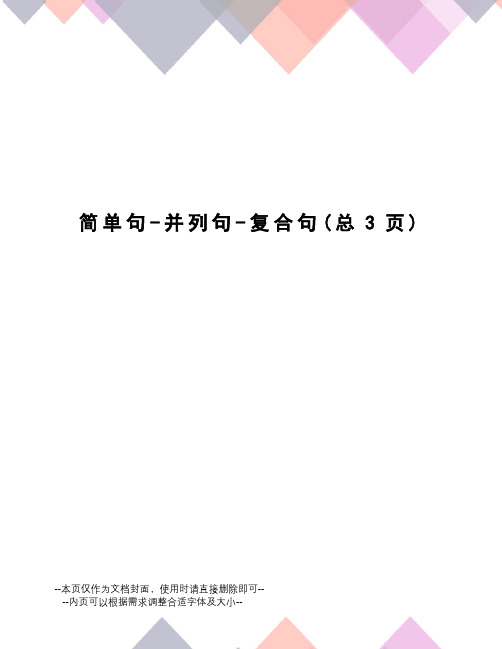
简单句-并列句-复合句(总3页)--本页仅作为文档封面,使用时请直接删除即可----内页可以根据需求调整合适字体及大小--简单句、并列句和复合句一句子可以分为简单句、并列句和复合句:1) 简单句:有时句子虽长, 但只有一个主谓结构, 仍是简单句, 例如:Yesterday we went to an exhibition on the life and work of Lenin, the great revolutionary leader of the working class.有时一个句子有两个(或两个以上)并列的主语或谓语, 也仍然是简单句There he was a leader of the student movement and took an active part in revolutionary work. Both the teachers and the students were very active in physical labour.Comrade Yang and I often study together and help each other.2) 并列句:一个句子如果包含两个或更多的互不依从的主谓结构, 就称为并列句。
He was always close to the people, and the people loved him.I didn't make any mistakes in the test, but my handwriting was poor.Some are walking by the lake, others are sitting on the benches and chatting.并列的各个部分(即各个主谓结构)称为分句。
各个分句用并列连词(如 and, but 等)连接;在上下文紧密联系的情况下也可不用连词, 而以逗号隔开(如上面第三句)。
中考英语语法专项复习:简单句、并列句和复合句
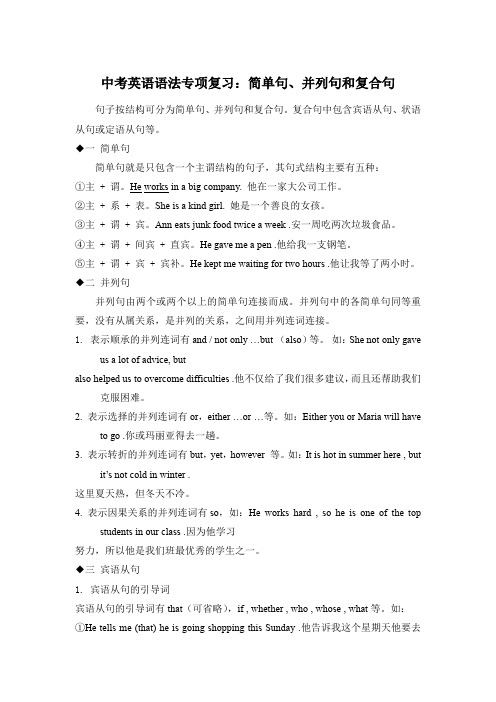
中考英语语法专项复习:简单句、并列句和复合句句子按结构可分为简单句、并列句和复合句。
复合句中包含宾语从句、状语从句或定语从句等。
◆一简单句简单句就是只包含一个主谓结构的句子,其句式结构主要有五种:①主 + 谓。
He works in a big company. 他在一家大公司工作。
②主 + 系 + 表。
She is a kind girl. 她是一个善良的女孩。
③主 + 谓 + 宾。
Ann eats junk food twice a week .安一周吃两次垃圾食品。
④主 + 谓 + 间宾 + 直宾。
He gave me a pen .他给我一支钢笔。
⑤主 + 谓 + 宾 + 宾补。
He kept me waiting for two hours .他让我等了两小时。
◆二并列句并列句由两个或两个以上的简单句连接而成。
并列句中的各简单句同等重要,没有从属关系,是并列的关系,之间用并列连词连接。
1. 表示顺承的并列连词有and / not only …but (also)等。
如:She not only gaveus a lot of advice, butalso helped us to overcome difficulties .他不仅给了我们很多建议,而且还帮助我们克服困难。
2. 表示选择的并列连词有or,either …or …等。
如:Either you or Maria will haveto go .你或玛丽亚得去一趟。
3. 表示转折的并列连词有but,yet,however 等。
如:It is hot in summer here , butit’s not cold in winter .这里夏天热,但冬天不冷。
4. 表示因果关系的并列连词有so,如:He works hard , so he is one of the topstudents in our class .因为他学习努力,所以他是我们班最优秀的学生之一。
简单句、并列句和复合句(包括五大句型)
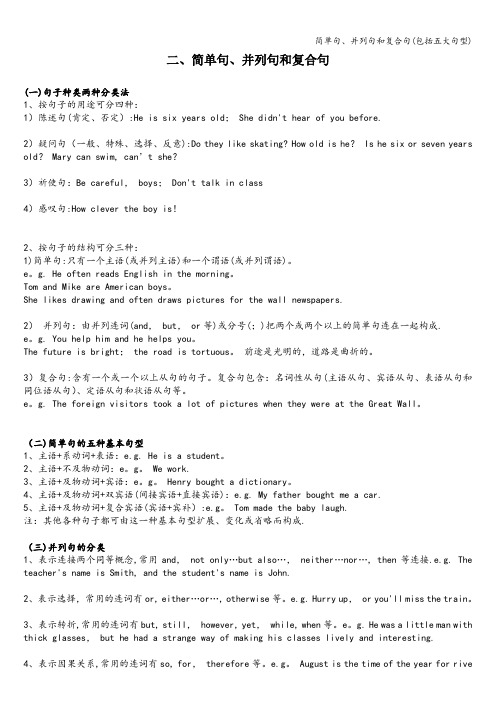
二、简单句、并列句和复合句(一)句子种类两种分类法1、按句子的用途可分四种:1)陈述句(肯定、否定):He is six years old; She didn't hear of you before.2)疑问句(一般、特殊、选择、反意):Do they like skating? How old is he? Is he six or seven years old? Mary can swim, can’t she?3)祈使句:Be careful, boys; Don't talk in class4)感叹句:How clever the boy is!2、按句子的结构可分三种:1)简单句:只有一个主语(或并列主语)和一个谓语(或并列谓语)。
e。
g. He often reads English in the morning。
Tom and Mike are American boys。
She likes drawing and often draws pictures for the wall newspapers.2)并列句:由并列连词(and, but, or等)或分号(;)把两个或两个以上的简单句连在一起构成.e。
g. You help him and he helps you。
The future is bright; the road is tortuous。
前途是光明的,道路是曲折的。
3)复合句:含有一个或一个以上从句的句子。
复合句包含:名词性从句(主语从句、宾语从句、表语从句和同位语从句)、定语从句和状语从句等。
e。
g. The foreign visitors took a lot of pictures when they were at the Great Wall。
(二)简单句的五种基本句型1、主语+系动词+表语:e.g. He is a student。
英语句子类型(简单句、并列句、复合句)
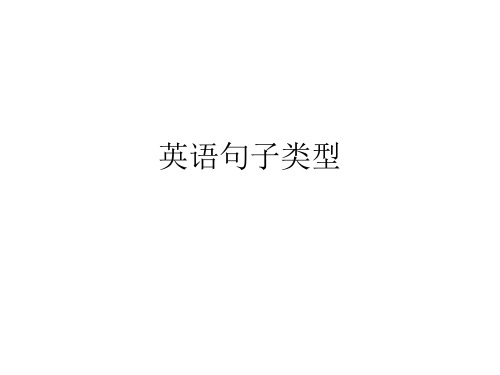
并列句
• 3.表示选择关系,常见连词有or,not...but(不是……而 是……),either...or...(要么……要么……)等。 • ①Hurry up, or we'll be late. • ②Either you come to my home or I get to yours.
放在名词或代词后面,由关系代词或关系副词引导的修饰该 名词或代词的从句叫定语从句。被修饰的名词或代词叫先行 词。
Harry Porter is a boy who has magic power.
先行词 关系词
关系代词
定语从句 关系副词 where, when, why
that,which, who, whom, whose
简单句的基本词序
主语 动词部分 (谓语) 宾语 状语 (方式 /地点/时间)
I
The children
bought
ran
a hat
yesterday.
home.
We
The car
ate
stopped
our meal
in silence.
suddenly.
并列句
• 由并列连词把两个或两个以上的简单句连接起来的句子叫 并列句。常见分类: • 1.表示同等、平行或承接关系,常用连词有and, both...and...,not only...but also...,neither...nor...,as well as等。 • ①He helps me and he also helps others. • ②She not only gave us a lot of advice, but also helped us to overcome difficulties. • 2.表示转折关系,常用连词有but,however, yet(然而), while(而)等。 • ①He is young, but he works hard. • ②She is tall, while her elder sister is short.
英语简单句、并列句、复合句
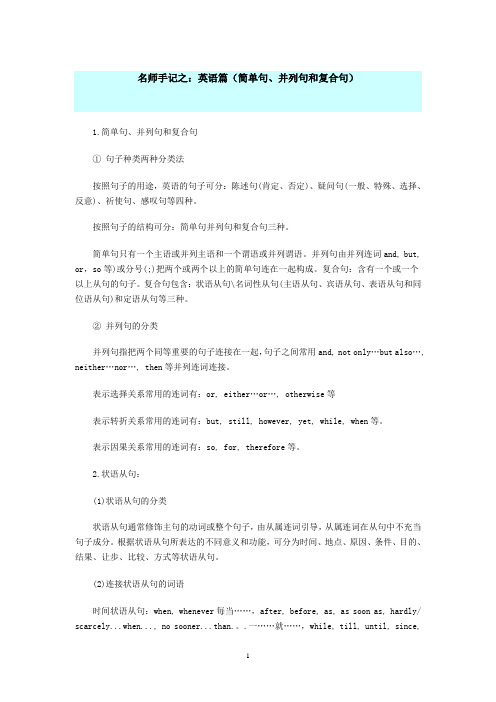
名师手记之:英语篇(简单句、并列句和复合句)1.简单句、并列句和复合句① 句子种类两种分类法按照句子的用途,英语的句子可分:陈述句(肯定、否定)、疑问句(一般、特殊、选择、反意)、祈使句、感叹句等四种。
按照句子的结构可分:简单句并列句和复合句三种。
简单句只有一个主语或并列主语和一个谓语或并列谓语。
并列句由并列连词and, but, or,so等)或分号(;)把两个或两个以上的简单句连在一起构成。
复合句:含有一个或一个以上从句的句子。
复合句包含:状语从句\名词性从句(主语从句、宾语从句、表语从句和同位语从句)和定语从句等三种。
② 并列句的分类并列句指把两个同等重要的句子连接在一起,句子之间常用and, not only…but also…, neither…nor…, then等并列连词连接。
表示选择关系常用的连词有:or, either…or…, otherwise等表示转折关系常用的连词有:but, still, however, yet, while, when等。
表示因果关系常用的连词有:so, for, therefore等。
2.状语从句:(1)状语从句的分类状语从句通常修饰主句的动词或整个句子,由从属连词引导,从属连词在从句中不充当句子成分。
根据状语从句所表达的不同意义和功能,可分为时间、地点、原因、条件、目的、结果、让步、比较、方式等状语从句。
(2)连接状语从句的词语时间状语从句:when, whenever每当……,after, before, as, as soon as, hardly/ scarcely...when..., no sooner...than.。
.一……就……,while, till, until, since,once。
名词词组the first time第一次,last time最后一次,every/each time每次,the next time下次,the next day第二天, the moment, the minute, the second, the instant 一……就……;副词immediately, instantly, directly等也可作连词使用。
简单句、并列句和复合句

简单句、并列句和复合句句子按结构可分为简单句、并列句和复合句。
复合句中包含宾语从句、状语从句或定语从句等。
◆一简单句简单句就是只包含一个主谓结构的句子,其句式结构主要有五种:①主 + 谓。
He works in a big company. 他在一家大公司工作。
②主 + 系 + 表。
She is a kind girl. 她是一个善良的女孩。
③主 + 谓 + 宾。
Ann eats junk food twice a week .安一周吃两次垃圾食品。
④主 + 谓 + 间宾 + 直宾。
He gave me a pen .他给我一支钢笔。
⑤主 + 谓 + 宾 + 宾补。
He kept me waiting for two hours .他让我等了两小时。
◆二并列句并列句由两个或两个以上的简单句连接而成。
并列句中的各简单句同等重要,没有从属关系,是并列的关系,之间用并列连词连接。
1. 表示顺承的并列连词有and / not only …but (also)等。
如:She not only gaveus a lot of advice, butalso helped us to overcome difficulties .他不仅给了我们很多建议,而且还帮助我们克服困难。
2. 表示选择的并列连词有or,either …or …等。
如:Either you or Maria will haveto go .你或玛丽亚得去一趟。
3. 表示转折的并列连词有but,yet,however 等。
如:It is hot in summer here , butit’s not cold in winter .这里夏天热,但冬天不冷。
4. 表示因果关系的并列连词有so,如:He works hard , so he is one of the topstudents in our class .因为他学习努力,所以他是我们班最优秀的学生之一。
英语句子成分及分类:简单句-并列句和复合句
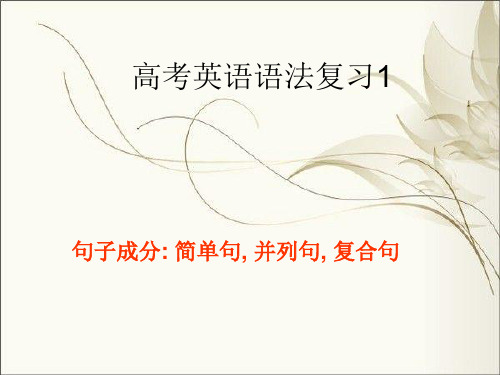
练习一
• 一、指出下列句子划线部分是什么句子成 分:
• 1. The students got on the school bus. • 2. He handed me the newspaper. • 3. I shall answer . What a beautiful Chinese painting! • 5. They went hunting together early in the
(五)宾语补足语
• 英语中有些及物动词,除有一个直接宾语 以外,还要有一个宾语补语,才能使句子 的意义完整。带有宾语补足语的一般句型 为:某些及物动词(如make等+宾语+宾 补)。宾补可由名词、形容词、副词、不 定式、分词、介词短语和从句充当。例如:
1. His father named him Dongming.(名词) 2. They painted their boat white.(形容词) 3. Let the fresh air in.(副词)
• 2、复合谓语:(1)由情态动词或其他助动 词加动词原形构成。如:You may keep the book for two weeks. He has caught a bad cold. (2) 由系动词加表语构成。如:We are students.
(三)表语
• 表语用以说明主语的身份、特征和状态, 它一般位于系动词(如be, become, get, look, grow, turn, seem等)之后。表语一般 由名词、代词、形容词、分词、数词、不 定式、动名词、介词短语、副词及表语从 句表示。例如:
morning.
• 6. His job is to train swimmers. • 7. He took many photos of the palaces in
英语句子分类之简单句,并列句和复合句

英语句子结构分类英语句子结构分类:简单句,并列句和复合句的概念及区别1.简单句:无论句子长短,只包含一套主谓结构,句子中个个成分都是单词或短语。
有时主语或谓语可以是并列结构。
请划出下面句子的主谓宾成分。
The accident happened yesterday afternoonOur English teacher is thirty years old.He put the dictionary in the backpack.Grandma told me an interesting story last night.She kept the door open.My classmates and friends all received my Christmas cards and thanked me very much.2.并列句: 由并列连词and/but/or/so/however/for等把两个或两个以上的简单句连接起来。
如:Come here and I’ll help you. 请划出两个分句并判断各分句的成分。
并列连词:一、表转折的并列连词主要有but(但是), yet(可是), while(而,却)等二、表选择的并列连词主要or (或者,还是,否则), either, or (不是、就是), neither, or,(既不、也不) otherwise (要不然)等。
三、表联合的并列连词主要有and, not only, but also,(不但,而且), when(=and just at this time 就在这时)等。
四、表因果的并列连词主要有for(因为), so(因此)等。
并列句例句:1. This is the custom of China. They are not like us to finish it in one drink, _____but_____prefer to drink by taking a small amount at a time.2. My mother wants to decorate our rooms in a modem look__while_____my father prefers a traditional style.3. It was time for her to have a new baby, ___and____it was also time for the young panda to independent.4. He is a shy man,__but/yet_______he is not afraid of anything or anyone. 解析:But/yet转折连词。
简单句、并列句、复合句
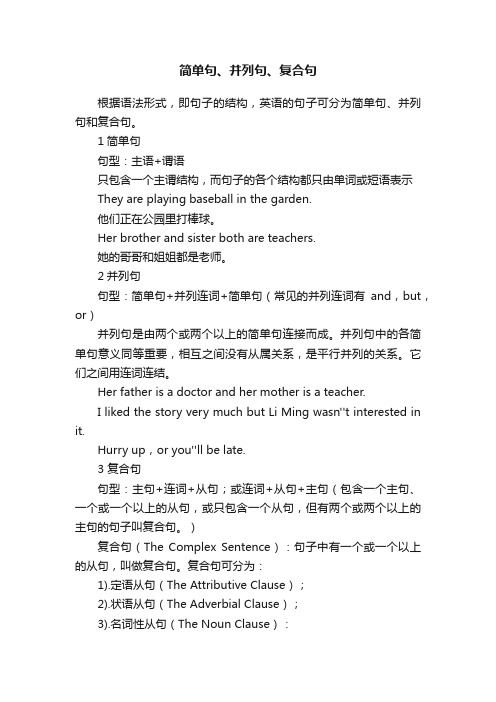
简单句、并列句、复合句根据语法形式,即句子的结构,英语的句子可分为简单句、并列句和复合句。
1简单句句型:主语+谓语只包含一个主谓结构,而句子的各个结构都只由单词或短语表示They are playing baseball in the garden.他们正在公园里打棒球。
Her brother and sister both are teachers.她的哥哥和姐姐都是老师。
2并列句句型:简单句+并列连词+简单句(常见的并列连词有and,but,or)并列句是由两个或两个以上的简单句连接而成。
并列句中的各简单句意义同等重要,相互之间没有从属关系,是平行并列的关系。
它们之间用连词连结。
Her father is a doctor and her mother is a teacher.I liked the story very much but Li Ming wasn''t interested in it.Hurry up,or you''ll be late.3 复合句句型:主句+连词+从句;或连词+从句+主句(包含一个主句、一个或一个以上的从句,或只包含一个从句,但有两个或两个以上的主句的句子叫复合句。
)复合句(The Complex Sentence):句子中有一个或一个以上的从句,叫做复合句。
复合句可分为:1).定语从句(The Attributive Clause);2).状语从句(The Adverbial Clause);3).名词性从句(The Noun Clause):一、定语从句定语从句的定义定语从句在句子中作定语,用来修饰一个名词、名词词组或者代词。
先行词和引导词被修饰的名词、名词词组或代词叫做先行词;在先行词和定语从句之间起连接作用的词叫做引导词。
引导词分为“关系代词”和“关系副词”。
关系代词和关系副词关系代词有:who, whom, whose, that, which, as。
(完整版)简单句、并列句、复合句、并列复合句
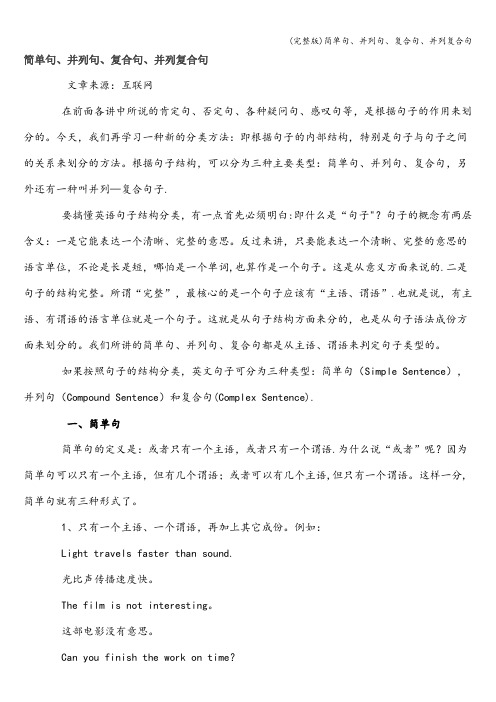
简单句、并列句、复合句、并列复合句文章来源:互联网在前面各讲中所说的肯定句、否定句、各种疑问句、感叹句等,是根据句子的作用来划分的。
今天,我们再学习一种新的分类方法:即根据句子的内部结构,特别是句子与句子之间的关系来划分的方法。
根据句子结构,可以分为三种主要类型:简单句、并列句、复合句,另外还有一种叫并列—复合句子.要搞懂英语句子结构分类,有一点首先必须明白:即什么是“句子"?句子的概念有两层含义:一是它能表达一个清晰、完整的意思。
反过来讲,只要能表达一个清晰、完整的意思的语言单位,不论是长是短,哪怕是一个单词,也算作是一个句子。
这是从意义方面来说的.二是句子的结构完整。
所谓“完整”,最核心的是一个句子应该有“主语、谓语”.也就是说,有主语、有谓语的语言单位就是一个句子。
这就是从句子结构方面来分的,也是从句子语法成份方面来划分的。
我们所讲的简单句、并列句、复合句都是从主语、谓语来判定句子类型的。
如果按照句子的结构分类,英文句子可分为三种类型:简单句(Simple Sentence),并列句(Compound Sentence)和复合句(Complex Sentence).一、简单句简单句的定义是:或者只有一个主语,或者只有一个谓语.为什么说“或者”呢?因为简单句可以只有一个主语,但有几个谓语;或者可以有几个主语,但只有一个谓语。
这样一分,简单句就有三种形式了。
1、只有一个主语、一个谓语,再加上其它成份。
例如:Light travels faster than sound.光比声传播速度快。
The film is not interesting。
这部电影没有意思。
Can you finish the work on time?你能按时完成工作吗?2、只有一个主语,但有几个谓语,再加上其它成份。
例如:The boy were running, shouting and laughing.男孩们一边跑,一边笑,一边喊叫着。
英语句子的分类

英语句子的分类英语句子按其语法结构可以分为简单句、并列句和复合句三种类型。
1. 简单句(Simple Sentence):只有一个主谓结构的句子。
例如:1) Things change.2) Fire and water do not agree.3) He came into the classroom and sit down.2. 并列句(Compound Sentence):包含两个或两个以上互不依从的主谓结构的句子。
并列句的各个分句常用一定的并列连词(coordinating conjunction)(FAN BOYS)、连接副词(conjunctive adverbs)和分号(semicolon)连接在一起。
例如:1) I hate jogging, but I love hiking.2) Fishes must stay in water, or they will die.3) Punctuation is important; therefore, don’t forget to use a comma before the coordinating conjunction in a compound sentence.4) This is the best book I have ever read; it kept me up all night.3. 复合句(Complex Sentence):由一个主句(main clause)和至少一个从句(subordinate clause)构成的句子。
从句须用关联词(connective)引导,来表明与主句的关系。
例如:1) She loves her dog as a mother loves her child.2) Although many people were unknown to each other before, they have got acquainted with each other through e-mail.3) When you go for a job interview, it is important to create a good fist impression.4. 并列复合句(Compound-Complex Sentence),例如:1). Jack, who reads comics, rarely reads novels; however, Tom enjoysnovels.2). While the men worked to strengthen the dam, the rain continued to fall, and the river, which was already well above its normal level, rose higher and higher.。
- 1、下载文档前请自行甄别文档内容的完整性,平台不提供额外的编辑、内容补充、找答案等附加服务。
- 2、"仅部分预览"的文档,不可在线预览部分如存在完整性等问题,可反馈申请退款(可完整预览的文档不适用该条件!)。
- 3、如文档侵犯您的权益,请联系客服反馈,我们会尽快为您处理(人工客服工作时间:9:00-18:30)。
名师手记之:英语篇(简单句、并列句和复合句)1.简单句、并列句和复合句① 句子种类两种分类法按照句子的用途,英语的句子可分:陈述句(肯定、否定)、疑问句(一般、特殊、选择、反意)、祈使句、感叹句等四种。
按照句子的结构可分:简单句并列句和复合句三种。
简单句只有一个主语或并列主语和一个谓语或并列谓语。
并列句由并列连词and, but, or,so等)或分号(;)把两个或两个以上的简单句连在一起构成。
复合句:含有一个或一个以上从句的句子。
复合句包含:状语从句\名词性从句(主语从句、宾语从句、表语从句和同位语从句)和定语从句等三种。
② 并列句的分类并列句指把两个同等重要的句子连接在一起,句子之间常用and, not only…but also…, neither…nor…, then等并列连词连接。
表示选择关系常用的连词有:or, either…or…, otherwise等表示转折关系常用的连词有:but, still, however, yet, while, when等。
表示因果关系常用的连词有:so, for, therefore等。
2.状语从句:(1)状语从句的分类状语从句通常修饰主句的动词或整个句子,由从属连词引导,从属连词在从句中不充当句子成分。
根据状语从句所表达的不同意义和功能,可分为时间、地点、原因、条件、目的、结果、让步、比较、方式等状语从句。
(2)连接状语从句的词语时间状语从句:when, whenever每当……,after, before, as, as soon as, hardly/ scarcely...when..., no sooner...than.。
.一……就……,while, till, until, since,once。
名词词组the first time第一次,last time最后一次,every/each time每次,the next time下次,the next day第二天, the moment, the minute, the second, the instant 一……就……;副词immediately, instantly, directly等也可作连词使用。
原因状语从句:because, since, as, now that。
地点状语从句:where,wherever(无论那里)。
让步状语从句: no matter who/whom/what/which/how/when/where, though, although, as, even if /even though, whatever, whoever, however, wherever, whenever等。
条件状语从句: if, unless, as/so long as(如果;只要),in case (万一); on condition that(如果), suppose, supposing, providing, provide。
目的状语从句:in order that (为了),so that (以便)。
比较状语从句:(not) as/so…as…,than…, the more…the more…(越……越……) 引导。
方式状语从句:as(正如;按照),as if/as though (好像)引导。
结果状语从句: so that (结果是),so/such…that (如此……以至于)。
(3)从句中的语序复合句中通常采用陈述语序。
但是,在下面的几种情况下,状语从句多采用倒装语序:①当连词as, though连接让步状语从句时,作表语的名词、形容词、动词通常置于句首,构成部分倒装语序。
例如:Much as I have traveled, I have never seen anyone who’s as capable as John。
Try as she might, Carol couldn't get the door open。
Strange though it may seem, I like housework。
②在so/such...that.。
.结果状语从句中,so+形容词/副词或such+名词置于句首时,主句采用部分倒装语序。
例如:So successful was her business that Marie was able to set up new branches elsewhere.Such was the force of the explosion that windows were blown out。
③在hardly/scarcely...when..., no sooner...than.。
.句式中,把hardly/scarcely/no sooner置于句首时,第一个分句采用部分倒装语序,即把第二个分句用陈述语序。
例如:Scarcely had he sat down when there was a knock at the door。
④ however与形容词、副词一起引导让步状语从句,句子采用陈述语序。
例如:However amusing the story is, I have to put it away and focus my attention on study this week。
⑤ 在the +比较级the+比较级句式中,只是把形容词或副词置于句首,句子仍然采用陈述语序。
例如:Education is about learning and the more you learn, the more equipped for life you are。
(4)从句和主句中谓语动词的时态在复合句中,主句和从句的谓语动词时态一般遵循以下的规律:①表示“同时”意义的连词as, when, as soon as, the moment, while 等连接的时间状语从句,主句和从句时态基本一致。
例如:As time passed, things seemed to get worse。
② 表示“将来”意义的条件、时间和让步状语从句中多用一般现在时,而主句用一般将来时,被称为“主将从现”。
例如:Tom won’t go to sleep unless his mother tells him a story。
Once I get him a job, he’ll be fine。
③ sin ce引导的时间状语从句多用一般过去时,而含有since从句的主句通常用现在完成时。
例如:I haven’t met her since I left university。
④在句式hardly/scarcely…when…, no sooner…than…中,第一个分句中过去完成时,第二个分句用一般过去时。
例如:She had hardly sat down when the phone rang。
⑤ 在as if/though 引导的状语从句中,如果表示一种与事实相反夸张,从句多用一般过去时或过去完成时。
例如:She stared at me as though I were a complete stranger。
(5)状语从句的省略当从句的主语与主句的主语相同时,被动结构的状语从句,可省略与主句相同的主语和助动词,保留连词+过去分词;主动结构的状语从句,可省略与主句相同的主语和助动词,保留连词+现在分词。
例如:We all know that, if not carefully dealt with, the situation will get worse。
Though lacking money, his parents managed to send him to university。
(6)状语从句被用于强调结构中状语从句作为被强调部分用于强调结构时,一律用It is/was …that…,不能用when 代替that。
句子用陈述语序。
注意:当强调Not until +时间/时间状语时,主句的谓语动词不再采用倒装语序。
例如:It was not until the war was over that the soldier was able to return home。
3. 名词性从句(1)名词性从句分类:按照在句中的功能,名词性从句分为:主语从句、宾语从句、表语从句和同位语从句四种。
(2) 名词性从句的连接词名词性从句的连接词可分为三类:that无词义,在从句中不担任成分,有时可被省略;表示“是否”用whether,只有在宾语从句中,whether可被人if代替。
Whether和if在从句中不担任成分。
如果从句缺少主语、表语、宾语、或定语等句子成分,用连接代词what, whatever, who, whoever, whom, whose, which;如果从句缺少状语,用连接副词when, where, how, why。
由于连接代词与连接副词在句中不再是疑问句,因而从句中谓语不用疑问语序。
连接代词与连接副词在从句充当句子成分,而连接词whether 和if(是否),在从句中不充当句子成分,只起连接作用。
(3) 名词性从句中的特殊时态① 在以下三种主语从句中,主语从句的谓语动词要用“should+动词原形”, should 可省略。
(1)It is+形容词+that…句型。
常见的形容词有important, necessary, natural, funny, strange, surprising, astonishing(令人惊讶的)等。
(2) It is +名词+that…句型。
常见的名词有pity, shame, advice, suggestion, proposal(提议,建议), requirement, request, desire, order等。
(3) It is+动词的过去分词+ that…句型。
常见的动词有advise, order, propose, request, suggest, demand, require等。
②在insist(坚持), urge (催促), order(命令), command(命令), suggest(建议),advise(建议),recommend(建议,推荐), request(请求,要求), demand(要求),require(要求,需要)等动词后的宾语从句中,谓语动词用“should+动词原形”, should可省略。
③ 在含有advice, order, demand, proposal(提议), requirement, suggestion等名词的表语从句、同位语从句中,谓语动词用“should+动词原形”,should可省略。
